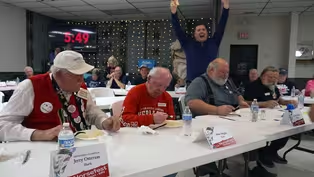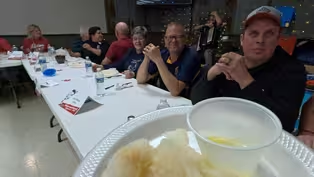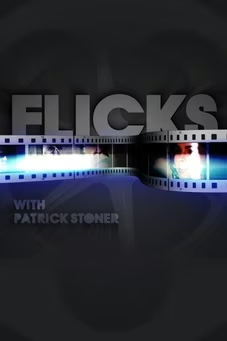
Robbie LaFleur
Clip: Season 15 Episode 11 | 13m 44sVideo has Closed Captions
Robbie LaFleur is a weaver and writer who has a fascination for textile arts.
Robbie LaFleur is a weaver and writer who has a fascination for textile arts, in particular Norwegian billedvev, also known as tapestry. She is the editor of the Norwegian Textile Letter, a quarterly publication about Scandinavian fiber crafts. Before joining the world of weaving, LaFleur was a librarian at the Minnesota Legislative Reference Library.
Problems playing video? | Closed Captioning Feedback
Problems playing video? | Closed Captioning Feedback
Postcards is a local public television program presented by Pioneer PBS
Production sponsorship is provided by contributions from the voters of Minnesota through a legislative appropriation from the Arts and Cultural Heritage Fund, Explore Alexandria Tourism, Shalom Hill Farm, Margaret A. Cargil Foundation, 96.7kram and viewers like you.

Robbie LaFleur
Clip: Season 15 Episode 11 | 13m 44sVideo has Closed Captions
Robbie LaFleur is a weaver and writer who has a fascination for textile arts, in particular Norwegian billedvev, also known as tapestry. She is the editor of the Norwegian Textile Letter, a quarterly publication about Scandinavian fiber crafts. Before joining the world of weaving, LaFleur was a librarian at the Minnesota Legislative Reference Library.
Problems playing video? | Closed Captioning Feedback
How to Watch Postcards
Postcards is available to stream on pbs.org and the free PBS App, available on iPhone, Apple TV, Android TV, Android smartphones, Amazon Fire TV, Amazon Fire Tablet, Roku, Samsung Smart TV, and Vizio.
Providing Support for PBS.org
Learn Moreabout PBS online sponsorship(cheerful music) - You can choose to study history through food or you could study architecture or other types of art.
For me, textiles are the material culture that I find so interesting to use to examine history (classical music) (cheery music) In many countries and tapestry traditions, you would use a series of elaborate types of feeders, and in Norway, they just tend to use a fork.
And so that's the way I learned to weave tapestry and it's the way I've continued.
(mysterious folk music) I grew up on a farm in Bygland outside of East Grand Forks, Minnesota, and I came down to the University of Minnesota.
It was the big city, I wanted to go to the big college, and I came down and stayed for the weekend with my Great Aunt Eileen, who was a school teacher in Minneapolis.
She said to me, she goes, "You must take Norwegian."
Then I took some weaving classes during college, and when I finished college, I decided, well, I really want to improve my Norwegian.
So I decided to go to weaving school in Norway and started a six month adventure of only speaking Norwegian.
I came back and I went to graduate school and I became a librarian, and I spent the majority of my career with the Minnesota Legislative Reference Library.
I had the best career ever.
I grew up with technology in libraries and in the legislature.
So I did decades of research, which was my love.
And in the meantime, I continued to weave and I always said, "Well, I wish I had more time to weave.
I wish I had more time to weave."
And so when it came time for early retirement, I thought, "Now... Now I'm gonna weave all the time."
I got a studio and I set up my giant loom there and boxes and boxes of yarn, and I did weave, well, quite a bit.
What I learned though, that after the decades of research that I enjoy the research and investigation as much as I do the actual weaving, so kind of gone on two parallel tracks.
I also started to edit the Norwegian Textile Letter.
It's a marvelous newsletter, I have many contributors, many people who write articles in Norway and in the United States, people who translate for me and I write things, and there's never a lack of material to write about.
(lively folk music) I think with my interest in Scandinavian weaving, that being in Minnesota and having access to the Weavers Guild of Minnesota, and our Scandinavian Weavers Study Group has been so enriching.
There is a group of us putting on this warp, and if you look underneath, you can see that several people have already woven pieces in different colors.
And for me at home, I no longer have a big floor loom, but yet if I keep participating in the group projects here doing these, then I still get to weave those types of techniques as well as tapestry.
My strongest mentor in weaving was Lila Nelson and I remember as a young woman in college, seeing some weavings done by Lila and thinking, "Oh my gosh, if I could ever weave like Lila.
Oh, what if I met Lila?"
And then she turned out to be a wonderful friend for many years.
So Lila was important in the Scandinavian Weavers Group, and the Weavers Guild in general, is a really strong community of weavers.
(calming folk music) There was a very famous Norwegian tapestry weaver at the turn of the 20th century named Frida Hansen.
And a museum curator called and said, "There was this tapestry of these swans and maidens Sørover or Southward, and it was bought by somebody in the US but we don't know where it is now.
Do you know where it is now?"
And my thought was, "Well, no I don't but I can find out.
I'm a librarian, I'll find out."
(intriguing music) So I launched on this research and discovered a lot about the woman who bought it, Berthea Aske Bergh in 1903.
And she displayed it multiple times in museums and in private galleries until about 1930, and then it disappeared.
There were no more news articles about it.
I went to the New York Public Library Archives, I went to archives in Brooklyn to see if there were probate records, I went to museum collections and I turned up dry.
I had written an article in the Norwegian Textile Letter, "Will We Ever Find the Missing Swans and Maidens?"
And then a couple of years later, Peter Pap, who is a noted rug dealer on the east coast, sent me an email and he said, "I found your missing swans and maidens!"
As it turned out, he had found it in the estate of a friend of his who had died.
And he unfolded this beautiful tapestry that's 10 feet by 11 feet.
It's huge and it was in perfect condition.
And he Googled it and the first thing he came up with, was my articles.
I didn't actually solve that mystery myself, but I got to be involved in the...
When it was cleaned and when it was displayed and I've done lectures about the piece and about Frida Hansen, so Frida Hansen is much closer to me now.
(calming piano music) So when you get a skein of yarn, it comes like this and you have to make it into a ball.
(tool gears spinning) Textiles have had value in different ways.
They are important to staying alive, you had to have thick woolen textiles in order to stay warm in a snowy northern climate.
But also over the centuries, there have been beautiful decorative techniques that have evolved and that was very important to the family and showed wealth and the cleverness of the weaver.
I think textiles have been highly valued within Norwegian culture, within folk culture in many places around the world.
(relaxing classical piano music) I would say that whatever I make is never just a reproduction of an old textile, even though I think that is also a very valuable thing to do.
But I do appreciate the historical Norwegian tapestry or billedvev, it's called billedvev, which actually means picture weaving.
So I really like this sort of flat abstracted yet sort of fresh look of the tapestries.
And so I've made a couple that are in that spirit and one is the one of my great-grandmother with chickens.
And it's based on a photograph that's from about 1898.
And the other one I made is, I always wanted to make a billedvev with a blue horse, or a red horse, or a green horse because those show up in the old ones.
So I made a tapestry similar to part of one of the tapestries owned by Vesterheim Norwegian-American Museum.
This is the tapestry of my daughter as a queen.
So I wove the blue horse but I put my daughter on the horse and rather than a ruff, she has a scarf and she's holding a cell phone so it's pretty modern.
But lots of elements of the old, historical Norwegian textiles are in the background.
This was a common tree that was on the edge but here's the surveillance camera that's... After I developed my research interest and my personal weaving interest in historical Norwegian billedvev I taught workshops at Vesterheim and elsewhere.
Now I've developed my expertise in Frida Hansen's Transparent Tapestry Workshop and I am loving doing the workshops in this technique.
It's so engaging and energizing to see other people discover the technique.
Looking at the pieces I've made and seeing people understand the technique and decide what they're going to do, is enormously fun.
(lively folk music) I once had a weaving teacher, a tapestry weaving teacher named Ingvar Bølgan who's still teaching tapestry in Norway and I loved what she said, "Tradition can't stand still, you always have to be moving forward.
You can't just copy the old stuff, you have to bring something new to it."
She also was the person that said, "Postage stamps!
People are only weaving tiny postage stamps, you need to weave big!"
And and I like to do that too, so I always try to weave big.
Weaving is something that has insinuated into my life in a myriad of ways.
It's interesting historically, it tells me about the material culture, but also when I am weaving, it's a puzzle to figure out what's going to happen and will I have to take it out and figure it out all again.
I think that weaving is like any handcraft in that you can solve... You solve problems and in that way, I think you gain confidence in all sorts of areas of your life.
(lively folk music) (upbeat music) (upbeat music continues) - [Narrator] "Postcards" is made possible by the Minnesota Arts and Cultural Heritage Fund and the citizens of Minnesota.
Additional support provided by Margaret A. Cargill Philanthropies.
Mark and Margaret Yackel-Juleen, on behalf of Shalom Hill Farms, a retreat and conference center in a prairie setting near Windom, Minnesota.
On the web at shalomhillfarm.org.
Alexandria, Minnesota, a year-round destination with hundreds of lakes, trails and attractions for memorable vacations and events.
More information at explorealex.com.
The Lake Region Arts Council's arts calendar, an arts and cultural heritage funded digital calendar showcasing upcoming art events and opportunities for artists in West Central Minnesota.
On the web at lrac4calendar.org.
Playing today's new music, plus your favorite hits, 96.7 KRAM, online at 967kram.com.
(upbeat music)
Video has Closed Captions
Clip: S15 Ep11 | 14m 31s | Postcards captures the 50th anniversary of Madison, Minnesota's annual lutefisk eating contest. (14m 31s)
Norwegian Weaver and Lutefisk Eating Contest
Preview: S15 Ep11 | 40s | Robbie LaFleur's Norwegian-inspired tapestries and a Lutefisk Eating Contest (40s)
Providing Support for PBS.org
Learn Moreabout PBS online sponsorshipSupport for PBS provided by:
Postcards is a local public television program presented by Pioneer PBS
Production sponsorship is provided by contributions from the voters of Minnesota through a legislative appropriation from the Arts and Cultural Heritage Fund, Explore Alexandria Tourism, Shalom Hill Farm, Margaret A. Cargil Foundation, 96.7kram and viewers like you.























